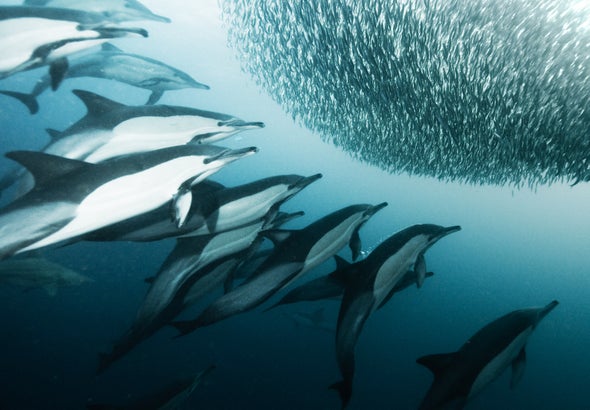(单词翻译:单击)
听力文本
This is Scientific American — 60-Second Science. I'm Christopher Intagliata.
Long before dolphins swam the seas, their near look-alike ichthyosaurs inhabited the earth's oceans. Now scientists say these ancient seafaring reptiles may have had more in common with modern-day sea turtles and marine mammals than we knew.
Over time, a dead animal's bones can be slowly replaced by minerals, leaving behind a rocky fossil. The researchers demineralized the 180-million-year-old fossil of an ichthyosaur...leaving them with soft, flexible tissues.
"Which is kind of amazing."
Johan Lindgren, a paleontologist at Lund University in Sweden. "It turns out that the skin, is still there, with cells and cellular organelles. And even traces of the original biomolecular makeup."
Those remains revealed that the ichthyosaur sported camouflage appropriate for its underwater environment—light on the bottom, darker on top—like many marine animals have today.

The researchers also found a black, glossy substance that was harder to identify. So they collected dead sea turtles and porpoises and mimicked fossilization by heating and squashing the creatures' skin. Which led them to realize that that the darker substance in the ichthyosaur fossil must be blubber.
"So from having blubber we can say that, to some extent the ichthyosaurs must have been warm blooded, so to say. At least to the same degree as the modern leatherback turtle."
The write-up and photos of the fossil are in the journal Nature.
There's one more intriguing secret contained in the remains: proteinaceous material. Which makes you wonder if you sequenced it, could you go backwards, and reconstruct the DNA that coded for the proteins?
In other words: (Jurassic Park clip: "Bingo... Dino DNA!)
Of course, ichthyosaurs were not dinosaurs, but the Jurassic Park methodology is what's important. So, could we resurrect one starting from their protein sequences?
"Yeah well, perhaps. You should never say never!"
Thanks for listening for Scientific American — 60-Second Science. I'm Christopher Intagliata.
参考译文
这里是科学美国人——60秒科学。我是克里斯托弗·因塔利亚塔。
远远早于海豚在海中畅游之前,外形与其极为相似的鱼龙就已经栖息在地球的海洋中了。现在科学家表示,这些古老海洋爬行动物与现代海龟和海洋哺乳动物之间的相同之处,可能比我们所知道的还要多。
随着时间的推移,死亡动物的骨头会慢慢由矿物质取代,最后变成岩石化石。研究人员对1.8亿年前的鱼龙化石进行了去矿物质处理,留下柔软且有韧性的组织。
“这个过程有些不可思议。”
瑞典隆德大学的古生物学家约翰·林德格伦说到。“结果发现,有细胞和细胞器的鱼龙皮肤仍在。甚至还有原始生物分子构造的印记。”
这些遗留物揭示,鱼龙产生了适合水下环境的伪装——即下腹部颜色较浅,而上表面颜色较深——这与现今众多海洋生物一样。
研究人员还发现了一种更难辨别的黑色光滑物质。因此,他们收集了海龟和海豚的尸体,然后通过加热和挤压它们的皮肤来模拟石化过程。这让他们意识到,鱼龙化石中的较暗物质一定是脂肪。
“因此,从拥有脂肪这一点可以看出,从某种程度上来说,鱼龙一定是温血动物。至少和现代棱皮龟一样。”
他们的报告和化石照片刊登在《自然》期刊上。
遗留物中还有一个更有趣的秘密:蛋白质物质。这让人们想知道,如果对其进行测序,那能否重建蛋白质编码DNA?
换句话说:(《侏罗纪公园》片段:“没错……是恐龙的DNA!”)
当然,鱼龙不是恐龙,但《侏罗纪公园》中提到的方法才是重点。那么,我们能从它们的蛋白质序列入手并复活一只鱼龙吗?
“嗯,可能吧。永远不要说不可能!”
谢谢大家收听科学美国人——60秒科学。我是克里斯托弗·因塔利亚塔。
译文为可可英语翻译,未经授权请勿转载!
重点讲解
重点讲解:
1. have in common 共有的;共同的;
The two cultures have a lot in common.
这两种文化具有许多相同之处。
2. turn out 原来是;结果发现;
The job turned out to be harder than we thought.
这工作结果比我们想象的要难。
3. to some extent 在某种程度上;
Biography must to some extent delineate characters.
传记必须在一定程度上描绘人物。
4. at least (表示更正或改变自己刚说过的话)至少,起码;
It's not difficult to get money for research or at least it's not always difficult.
争取到研究资金并不难,起码不总是那么难。


